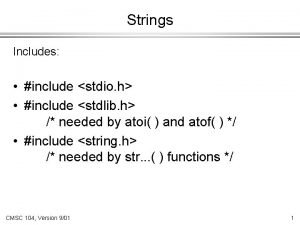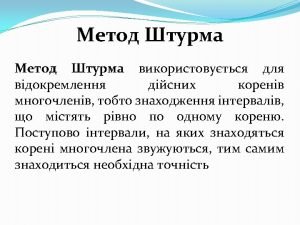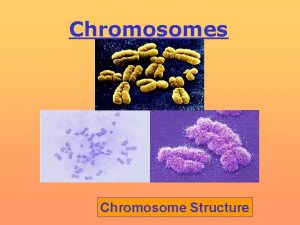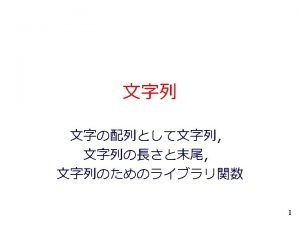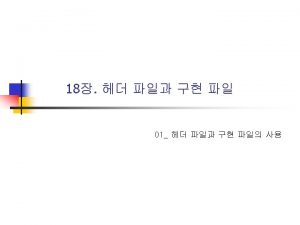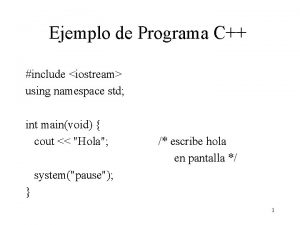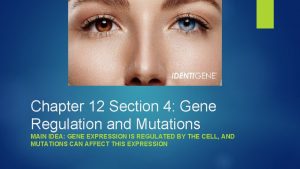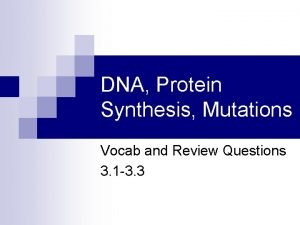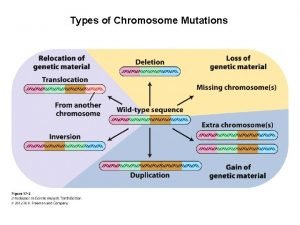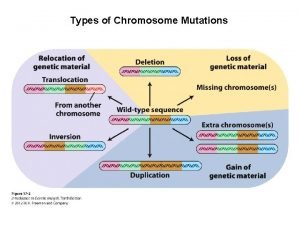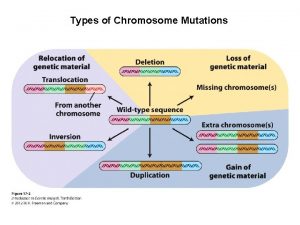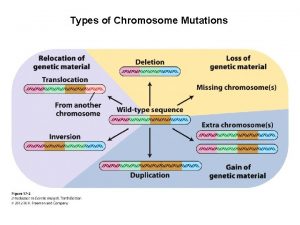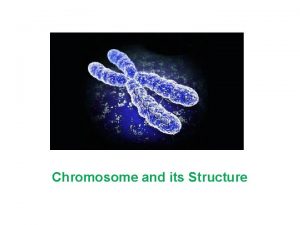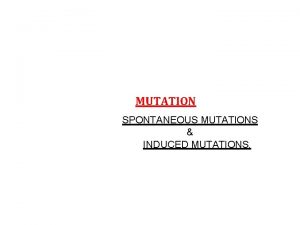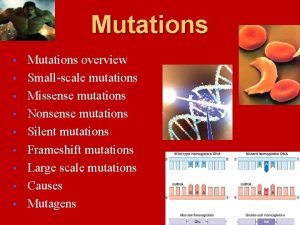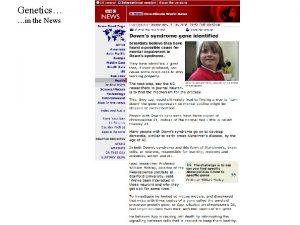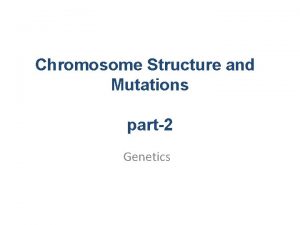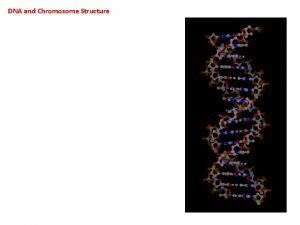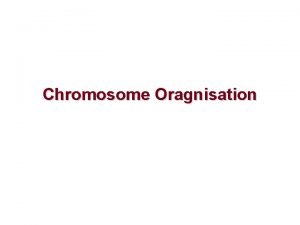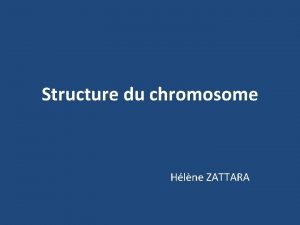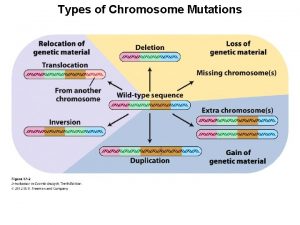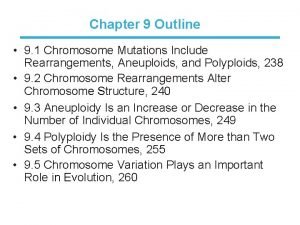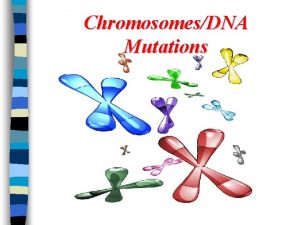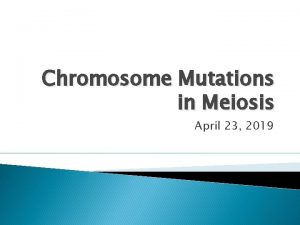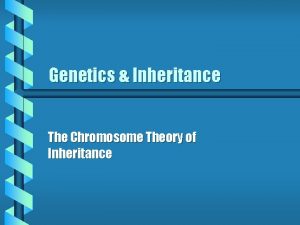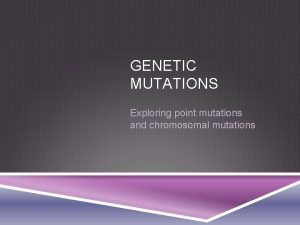Chromosome Structure and Mutations Genetics Chromosome Mutations Include




















- Slides: 20

Chromosome Structure and Mutations Genetics

Chromosome Mutations Include Rearrangements, Aneuploids, and Polyploids Before we consider the different types of chromosome mutations, their effects, and how they arise, we will review the basics of chromosome structure.

Chromosome Morphology Each functional chromosome has a centromere, to which spindle fibers attach, and two telomeres, which stabilize the chromosome. Chromosomes are classified into four basic types: 1. Metacentric. The centromere is located approximately in the middle, and so the chromosome has two arms of equal length. 2. Sub-metacentric. The centromere is displaced toward one end, creating a long arm and a short arm. (On human chromosomes, the short arm is designated by the letter p and the long arm by the letter q. ) 3. Acrocentric. The centromere is near one end, producing a long arm and a knob, or satellite, at the other end. 4. Telocentric. The centromere is at or very near the end of the chromosome.

§ The complete set of chromosomes possessed by an organism is called its karyotype and is usually presented as a picture of metaphase chromosomes lined up in descending order of their size. § Karyotypes are prepared from actively dividing cells, such as white blood cells, bone marrow cells, or cells from meristematic tissues of plants. § After treatment with a chemical (such as colchicine) colchicine that prevents them from entering anaphase, the cells are chemically preserved, spread on a microscope slide, stained, and photographed. § The photograph is then enlarged, and the individual chromosomes are cut out and arranged in a karyotype.

For human chromosomes, karyotypes are often routinely prepared by automated machines, which scan a slide with a video camera attached to a microscope, looking for chromosome spreads. When a spread has been located: a. the camera takes a picture of the chromosomes, b. the image is digitized, c. and the chromosomes are sorted and arranged electronically by a computer.

9. 1 A human karyotype consists of 46 chromosomes. A karyotype for a male is shown here; a karyotype for a female would have two X

Preparation and staining techniques help to distinguish among chromosomes of similar size and shape. ØFor instance, the staining of chromosomes with a special dye called Giemsa reveals G bands, which distinguish areas of DNA that are rich in adenine–thymine (A–T) base pairs.

Types of Chromosome Mutations § Chromosome mutations can be grouped into three basic categories: chromosome re-arrangements, aneuploids, and polyploids. § Chromosome rearrangements alter the structure of chromosomes; for example, a piece of a chromosome might be duplicated, deleted, or inverted. § In aneuploidy, the number of chromosomes is altered: one or more individual chromosomes are added or deleted. In polyploidy, one or more complete sets of chromosomes are added. Ø Some organisms (such as yeast) possess a single chromosome set (1 n) for most of their life cycles and are referred to as haploid, whereas others possess two chromosome sets and are referred to as diploid (2 n). § A polyploid is any organism that has more than two sets of chromosomes (3 n, 4 n, 5 n, or more).


Chromosome Rearrangements Alter Chromosome Structure Chromosome rearrangements are mutations that change the structures of individual chromosomes. The four basic types of rearrangements are duplications, deletions, inversions, and translocations.


Duplications § A chromosome duplication is a mutation in which part of the chromosome has been doubled. § Consider a chromosome with segments AB • CDEFG, in which • represents the centromere. § A duplication might include the EF segments, giving rise to a chromosome with segments AB • CDEFEFG. § This type of duplication, in which the duplicated region is immediately adjacent to the original segment, is called a tandem duplication. § If the duplicated segment is located some distance from the original segment, either on the same chromosome or on a different one, the chromosome rearrangement is called a displaced duplication. § An example of a displaced duplication would be AB • CDEFGEF. § A duplication can be either in the same orientation as that of the original sequence, as in the two preceding examples, or inverted: AB • CDEFFEG. When the duplication is inverted, it is called a reverse duplication.

Effects of chromosome duplications § An individual homozygous for a duplication carries the duplication on both homologous chromosomes, and an individual heterozygous for a duplication has one normal chromosome and one chromosome with the duplication. § In the heterozygotes, problems arise in chromosome pairing at prophase. I of meiosis, because the two chromosomes are not homologous throughout their length. § The pairing and synapsis of homologous regions require that one or both chromosomes loop and twist so that these regions are able to line up. § The appearance of this characteristic loop structure in meiosis is one way to detect duplications.


Deletions § A second type of chromosome rearrangement is a chromosome deletion, the loss of a chromosome segment. § A chromosome with segments AB • CDEFG that undergoes a deletion of segment EF would generate the mutated chromosome AB • CDG. § A large deletion can be easily detected because the chromosome is noticeably shortened. § In individuals heterozygous for deletions, the normal chromosome must loop during the pairing of homologs in prophase I of meiosis to allow the homologous regions of the two chromosomes to align and undergo synapsis. § This looping out generates a structure that looks very much like that seen for individuals heterozygous for duplications.

Effects of Deletions § The phenotypic consequences of a deletion depend on which genes are located in the deleted region. § If the deletion includes the centromere, the chromosome will not segregate in meiosis or mitosis and will usually be lost. § Many deletions are lethal in the homozygous state because all copies of any essential genes located in the deleted region are missing. § Even individuals heterozygous for a deletion may have multiple defects for three reasons. ? ?

§ First, the heterozygous condition may produce imbalances in the amounts of gene products, similar to the imbalances produced by extra gene copies. § Second, normally recessive mutations on the homologous chromosome lacking the deletion may be expressed when the wild-type allele has been deleted (and is no longer present to mask the recessive allele’s expression). The expression of a normally recessive mutation is referred to as pseudodominance, and it is an indication that one of the homologous chromosomes has a deletion. § Third, some genes must be present in two copies for normal function. When a single copy of a gene is not sufficient to produce a wild-type phenotype, it is said to be a haploinsufficient gene.


References § Benjamin A. Pierce, 2010. Genetics: A Conceptual Approach, 4 th Edition. W. H. Freeman.

The End
 #include stdio.h #include stdlib.h #include string.h
#include stdio.h #include stdlib.h #include string.h #include stdio.h #include conio.h #include stdlib.h
#include stdio.h #include conio.h #include stdlib.h #include stdio.h #include stdlib.h int main()
#include stdio.h #include stdlib.h int main() How to read chromosome
How to read chromosome Iostream
Iostream String h
String h #include iostream #include cmath
#include iostream #include cmath Include time
Include time Stdlib
Stdlib Fpos_t
Fpos_t Que es iostream en c++
Que es iostream en c++ #include iostream using namespace std
#include iostream using namespace std Chapter 12 section 4 gene regulation and mutations
Chapter 12 section 4 gene regulation and mutations Missense mutation in sickle cell anemia
Missense mutation in sickle cell anemia Protein synthesis and mutations
Protein synthesis and mutations Protein synthesis and mutations
Protein synthesis and mutations
